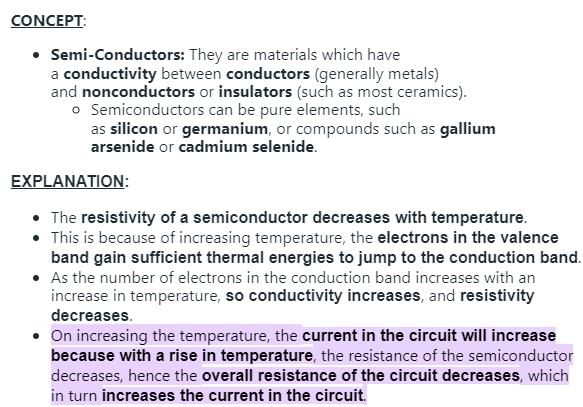Physics Exam > Physics Questions > A piece of semiconductor is connected in seri...
Start Learning for Free
A piece of semiconductor is connected in series in a circuit. On increasing the temperature, the current in the circuit will :
- a)cease to flow
- b)increase
- c)remains the same
- d)decrease
Correct answer is option 'B'. Can you explain this answer?
Verified Answer
A piece of semiconductor is connected in series in a circuit. On incre...
The circuit current will increase because as temperature of the semiconductor material increases , its resistance decreases .
The correct answer is: increase
The correct answer is: increase
Most Upvoted Answer
A piece of semiconductor is connected in series in a circuit. On incre...

Hence option B is correct
Free Test
FREE
| Start Free Test |
Community Answer
A piece of semiconductor is connected in series in a circuit. On incre...
Introduction:
Semiconductor materials are widely used in electronic circuits due to their unique electrical properties. One important property of semiconductors is that their conductivity changes with temperature. In this case, we are considering the effect of temperature change on the current flowing through a circuit containing a semiconductor material.
Explanation:
When the temperature of a semiconductor material is raised, the circuit current will increase. This can be explained by the following points:
1. Bandgap:
Semiconductors have a specific energy band structure, consisting of a valence band and a conduction band. The energy gap between these two bands is known as the bandgap. At low temperatures, the electrons in the valence band do not have sufficient energy to overcome the bandgap and move into the conduction band. As a result, the current flow is limited.
2. Electron Excitation:
When the temperature increases, the thermal energy of the electrons also increases. This additional energy enables more electrons to gain enough energy to cross the bandgap and enter the conduction band. As a result, more charge carriers (electrons) become available for conduction, leading to an increase in the circuit current.
3. Carrier Mobility:
The mobility of charge carriers in a semiconductor is another important factor. Carrier mobility refers to the ease with which charge carriers can move through the material. At higher temperatures, the lattice vibrations in the semiconductor increase, which can scatter the charge carriers and reduce their mobility. This scattering effect can lead to a slight decrease in the overall current flow.
4. Temperature Coefficient:
Semiconductor materials have a temperature coefficient for their conductivity. This coefficient determines how the conductivity of the material changes with temperature. In most cases, the temperature coefficient for semiconductors is positive, indicating that the conductivity increases with temperature.
5. Overall Effect:
Taking all these factors into account, when the temperature of the semiconductor material is raised, the increased thermal energy and the increased number of charge carriers result in a higher conductivity. This, in turn, leads to an increase in the circuit current.
Conclusion:
In summary, when a piece of semiconductor material is introduced in a circuit and the temperature is raised, the circuit current will increase. This is due to the increased thermal energy and the increased number of charge carriers available for conduction.
Semiconductor materials are widely used in electronic circuits due to their unique electrical properties. One important property of semiconductors is that their conductivity changes with temperature. In this case, we are considering the effect of temperature change on the current flowing through a circuit containing a semiconductor material.
Explanation:
When the temperature of a semiconductor material is raised, the circuit current will increase. This can be explained by the following points:
1. Bandgap:
Semiconductors have a specific energy band structure, consisting of a valence band and a conduction band. The energy gap between these two bands is known as the bandgap. At low temperatures, the electrons in the valence band do not have sufficient energy to overcome the bandgap and move into the conduction band. As a result, the current flow is limited.
2. Electron Excitation:
When the temperature increases, the thermal energy of the electrons also increases. This additional energy enables more electrons to gain enough energy to cross the bandgap and enter the conduction band. As a result, more charge carriers (electrons) become available for conduction, leading to an increase in the circuit current.
3. Carrier Mobility:
The mobility of charge carriers in a semiconductor is another important factor. Carrier mobility refers to the ease with which charge carriers can move through the material. At higher temperatures, the lattice vibrations in the semiconductor increase, which can scatter the charge carriers and reduce their mobility. This scattering effect can lead to a slight decrease in the overall current flow.
4. Temperature Coefficient:
Semiconductor materials have a temperature coefficient for their conductivity. This coefficient determines how the conductivity of the material changes with temperature. In most cases, the temperature coefficient for semiconductors is positive, indicating that the conductivity increases with temperature.
5. Overall Effect:
Taking all these factors into account, when the temperature of the semiconductor material is raised, the increased thermal energy and the increased number of charge carriers result in a higher conductivity. This, in turn, leads to an increase in the circuit current.
Conclusion:
In summary, when a piece of semiconductor material is introduced in a circuit and the temperature is raised, the circuit current will increase. This is due to the increased thermal energy and the increased number of charge carriers available for conduction.

|
Explore Courses for Physics exam
|

|
Question Description
A piece of semiconductor is connected in series in a circuit. On increasing the temperature, the current in the circuit will :a)cease to flowb)increasec)remains the samed)decreaseCorrect answer is option 'B'. Can you explain this answer? for Physics 2025 is part of Physics preparation. The Question and answers have been prepared according to the Physics exam syllabus. Information about A piece of semiconductor is connected in series in a circuit. On increasing the temperature, the current in the circuit will :a)cease to flowb)increasec)remains the samed)decreaseCorrect answer is option 'B'. Can you explain this answer? covers all topics & solutions for Physics 2025 Exam. Find important definitions, questions, meanings, examples, exercises and tests below for A piece of semiconductor is connected in series in a circuit. On increasing the temperature, the current in the circuit will :a)cease to flowb)increasec)remains the samed)decreaseCorrect answer is option 'B'. Can you explain this answer?.
A piece of semiconductor is connected in series in a circuit. On increasing the temperature, the current in the circuit will :a)cease to flowb)increasec)remains the samed)decreaseCorrect answer is option 'B'. Can you explain this answer? for Physics 2025 is part of Physics preparation. The Question and answers have been prepared according to the Physics exam syllabus. Information about A piece of semiconductor is connected in series in a circuit. On increasing the temperature, the current in the circuit will :a)cease to flowb)increasec)remains the samed)decreaseCorrect answer is option 'B'. Can you explain this answer? covers all topics & solutions for Physics 2025 Exam. Find important definitions, questions, meanings, examples, exercises and tests below for A piece of semiconductor is connected in series in a circuit. On increasing the temperature, the current in the circuit will :a)cease to flowb)increasec)remains the samed)decreaseCorrect answer is option 'B'. Can you explain this answer?.
Solutions for A piece of semiconductor is connected in series in a circuit. On increasing the temperature, the current in the circuit will :a)cease to flowb)increasec)remains the samed)decreaseCorrect answer is option 'B'. Can you explain this answer? in English & in Hindi are available as part of our courses for Physics.
Download more important topics, notes, lectures and mock test series for Physics Exam by signing up for free.
Here you can find the meaning of A piece of semiconductor is connected in series in a circuit. On increasing the temperature, the current in the circuit will :a)cease to flowb)increasec)remains the samed)decreaseCorrect answer is option 'B'. Can you explain this answer? defined & explained in the simplest way possible. Besides giving the explanation of
A piece of semiconductor is connected in series in a circuit. On increasing the temperature, the current in the circuit will :a)cease to flowb)increasec)remains the samed)decreaseCorrect answer is option 'B'. Can you explain this answer?, a detailed solution for A piece of semiconductor is connected in series in a circuit. On increasing the temperature, the current in the circuit will :a)cease to flowb)increasec)remains the samed)decreaseCorrect answer is option 'B'. Can you explain this answer? has been provided alongside types of A piece of semiconductor is connected in series in a circuit. On increasing the temperature, the current in the circuit will :a)cease to flowb)increasec)remains the samed)decreaseCorrect answer is option 'B'. Can you explain this answer? theory, EduRev gives you an
ample number of questions to practice A piece of semiconductor is connected in series in a circuit. On increasing the temperature, the current in the circuit will :a)cease to flowb)increasec)remains the samed)decreaseCorrect answer is option 'B'. Can you explain this answer? tests, examples and also practice Physics tests.

|
Explore Courses for Physics exam
|

|
Signup for Free!
Signup to see your scores go up within 7 days! Learn & Practice with 1000+ FREE Notes, Videos & Tests.


















